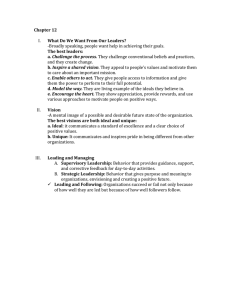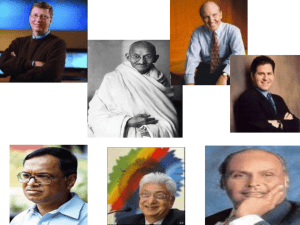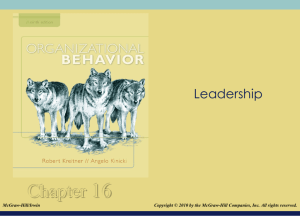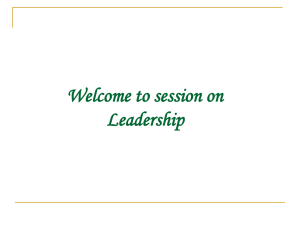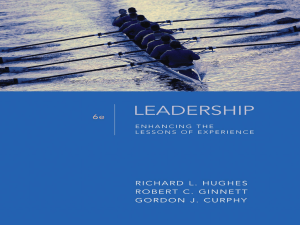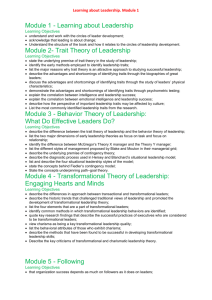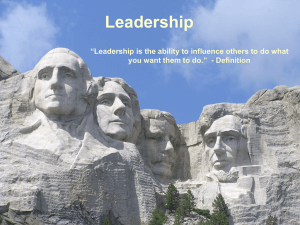Leadership Numerous theories and approaches to the concept of
advertisement
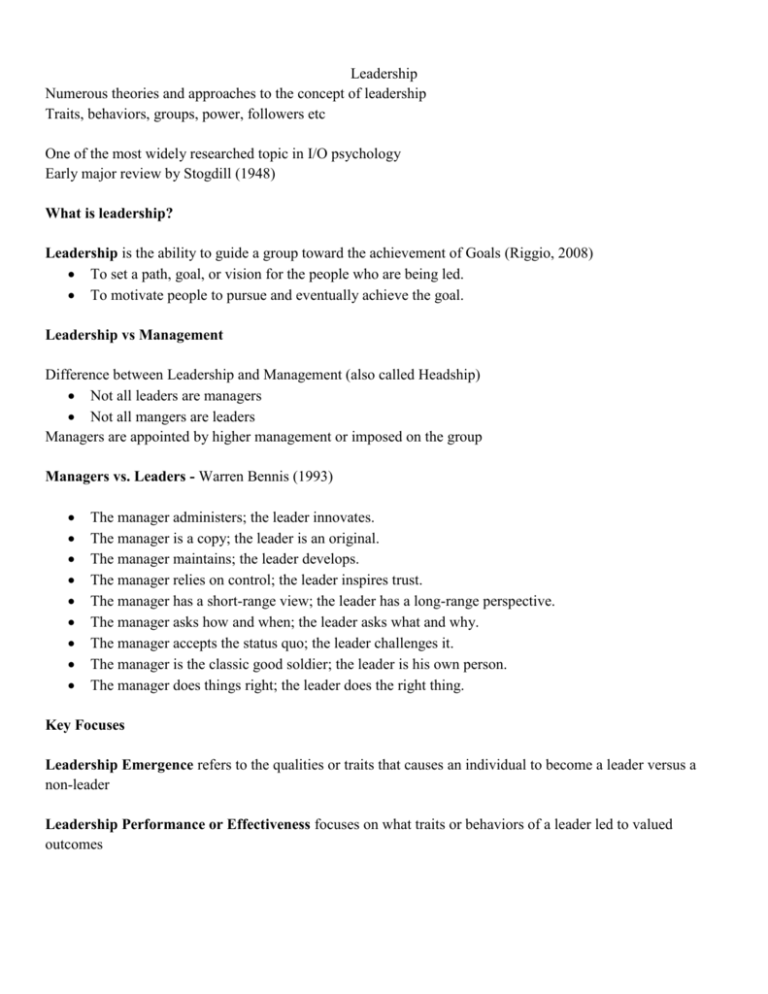
Leadership Numerous theories and approaches to the concept of leadership Traits, behaviors, groups, power, followers etc One of the most widely researched topic in I/O psychology Early major review by Stogdill (1948) What is leadership? Leadership is the ability to guide a group toward the achievement of Goals (Riggio, 2008) To set a path, goal, or vision for the people who are being led. To motivate people to pursue and eventually achieve the goal. Leadership vs Management Difference between Leadership and Management (also called Headship) Not all leaders are managers Not all mangers are leaders Managers are appointed by higher management or imposed on the group Managers vs. Leaders - Warren Bennis (1993) The manager administers; the leader innovates. The manager is a copy; the leader is an original. The manager maintains; the leader develops. The manager relies on control; the leader inspires trust. The manager has a short-range view; the leader has a long-range perspective. The manager asks how and when; the leader asks what and why. The manager accepts the status quo; the leader challenges it. The manager is the classic good soldier; the leader is his own person. The manager does things right; the leader does the right thing. Key Focuses Leadership Emergence refers to the qualities or traits that causes an individual to become a leader versus a non-leader Leadership Performance or Effectiveness focuses on what traits or behaviors of a leader led to valued outcomes Great Man/Woman Theory This was originally called the “Great Man” theory suggested first by Sir Francis Galton (1869) A universalist theory that states that great leaders are born, not made Led to the trait approach Trait Theory - Certain traits shared by leaders that are lacking among nonleaders Such traits as intelligence, charisma, and courage These traits may be genetic or acquired Stodgill (1974) compared the characteristics of leaders to non-leaders. A few characteristics were correlated with leadership, but the relationships were only weak. Meta-analysis Judge et al (2002) A resurgence in the trait approach since 1990s Big 5 Personality Traits (R = .48) Neuroticism or emotional stability (-.24) Extraversion (.31) Openness to experience (.24) Agreeableness (.08) Conscientiousness (.28) Behavioral approach- What do leaders do? Leadership style is a consistent set of behaviors exhibited by leader in dealing with subordinates The purpose: determine if one leadership style is superior to others Autocratic vs. Democratic Lewin, Lippitt and White (1943) looked at the effects of leader behavior on groups performance and morale within young boys’ after-school activities clubs. Young boys were trained to adopt one of three different styles: Autocratic Democratic Laissez-faire Meta-Analysis - Locke & Schweiger (1978) Job Satisfaction o 60% Democratic leadership o 9% Authoritarian leadership o 3% No difference Productivity o 22% Democratic leadership o 10% Authoritarian leadership o 56% No difference Behavioral Styles Theories Ohio State Studies identified two critical dimensions of leader behavior. Consideration: creating mutual respect and trust with followers Is interested in and listens to subordinates Allows participation in decision-making Is friendly and approachable Helps and supports staff behavior indicates trust, respect, warmth Initiating Structure: organizing and defining what group members should be doing Plans ahead Decides how things are to be done Assigns tasks Makes expectations clear Stresses achievement The University of Michigan Leadership Studies also identified two important leader behaviors. In task-orientated behaviors, leader behaviors focused on the work task. In relationship-oriented behaviors, leader behaviors focused on maintaining interpersonal relationships on the job. Managerial (Leadership) Grid In the 1960’sBlake and Mouton’s Managerial Grid represents four leadership styles found by crossing: Concern for Production (Task) Concern for People (Relationships) Situational Perspective According to the situational perspective, a leader is the person who best meets the requirements of the group’s current situation Fiedler’s contingency theory Fielder argued the effectiveness of each style is contingent on their match with the situation. The most important feature of the situation was the degree of control. Situational control is determined by three things: Leader-member relations refers to the quality of the relationship between leader and followers. Task structure is an assessment of how well elements of the work task are structured. Position power is a leader’s authority to punish or reward. Leadership Style Task Oriented – primarily concerned with getting the job done Relationship Oriented – primarily concerned with maintaining good group relations Relatively fixed and stable style Measured using the Least Preferred Coworker Scale LPC scores and performance Fiedler’s contingency theory First real contingency theory A lot of research (military) Results were generally supportive especially in lab studies compared to actual work settings Led to Fielder’s “Leadership Match” training program You recognize your style and understand key situational variables that you might be able to change Problems with contingency model What do LPC scores mean? Is it something to do with people’s personality? Decision Making and Leadership The Decision-making model by Vroom and Yetton (1973) is a theory that matches characteristics of the situation with leader decision-making strategies The theory provides different decision-making strategies. The theory predicts proper leader behavior in making decisions and gives “prescriptions” for the decision maker to follow. Results - Empirical evidence is generally supportive Vroom (1976) asked managers to give example of successful and unsuccessful decisions they recently made. These decisions were compared to the model. 65% of the managers whose own method fell within the feasible set had successful decision outcomes only 29% of those who failed to follow the model were successful. The probability of making a successful decision was doubled using the model On the downside the model is narrow and only focuses on decision making which is only one aspect of leadership. What about the role of followers? Charismatic leadership theory states that leaders possess some exceptional characteristics that cause followers to be loyal and inspired. Charismatic leaders communicate shared group goals and convey confidence in their own abilities and those of followers Transcendent Goal or Vision (House, 1977) - A transcendent goal is a moral mission for the group and the method to accomplish this mission. Charismatic leadership theory is an interaction of: Leadership characteristics o Ability to inspire, communication, risk taking Follower characteristics o Identification with leader, emotionally attached to leader, desire for change and growth Situational Circumstances o Uncertainty, crisis, opportunity for growth Key Behavioral Characteristics of Charismatic Leaders (Conger and Kanugo, 1987) Vision and articulation. - Has a vision—expressed as an idealized goal—that proposes a future better than the status quo; and is able to clarify the importance of the vision in terms that are understandable to others Personal risk. Willing to take on high personal risk, incur high costs and engage in self-sacrifice to achieve the vision Environmental sensitivity. Able to make realistic assessments of the environmental constraints and resources needed to bring about change Sensitivity to follower needs. Perceptive of others’ abilities and responsive to their needs and feelings Unconventional behavior. Engages in behaviors that are perceived as novel and counter to norms Charismatic Leaders Charismatic leaders are most effective when goals are unclear and situational conditions are unstable. Some researchers suggest that charismatic leaders possess exceptionally high-quality social skills and an ability to inspire followers at a deep emotional level (Riggio, 1987) May be helpful in understanding voluntary organizations Transformational Leadership - James MacGregor Burns (1978) first discussed difference between Political leaders Applied to organization by Bass (1985) Transformational leadership focuses on the leader’s ability to provide shared values and a vision for the future of the work group. Transactional Leadership focuses on the ability of the leader to exchange or make transactions Meta-analyses find that transformational leadership is better in fostering work group effectiveness Follower are more satisfied Concerns with the “DARK” side of charismatic leaders

